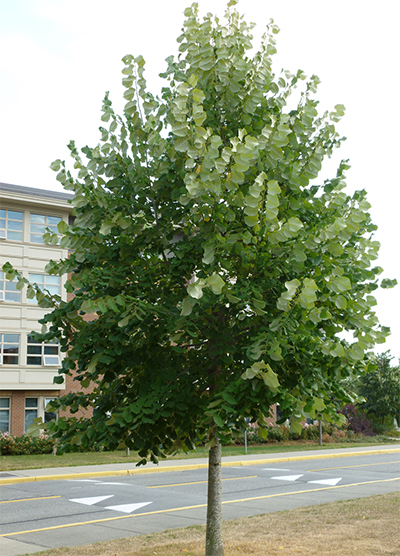CSU RESEARCH UPDATE
By James E. Klett, Ph.D., CSU Professor & Extension Landscape Horticultural
Research continues at Colorado State University on evaluating new woody plants for Colorado and the Rocky Mountain region. Currently we have more than 1,200 different taxa of woody plants that we evaluate yearly for growth rate and habit, flower and fruit characteristics, landscape features, hardiness, foliage characteristics, and disease and insect resistance. The following seven woody plants performed extremely well during the 2017 growing season and should be considered more for use in Colorado landscapes, especially along the Front Range. Annual reports on the performance of each of these cultivars can be viewed at landscapeplants.agsci.colostate.edu.
 Acer truncatum X Acer platunoides ‘JFS-KW202’PP21838 – Crimson Sunset® Maple
Acer truncatum X Acer platunoides ‘JFS-KW202’PP21838 – Crimson Sunset® Maple
This hybrid has more heat tolerance, and its growth habit is more upright and compact. The foliage color is deep purple during the growing season and maintaining a maroon to reddish bronze for fall color. It is hardy to zone 4, and reaches a mature height of about 30 to 35 feet and width of 20 to 25 feet. The glossy, heat-resistant foliage on this hybrid defies heat and humidity by maintaining its rich, deep purple color through the summer months.
 Carpinus betulus ‘Frans Fontaine’ – Frans Fontaine Hornbeam
Carpinus betulus ‘Frans Fontaine’ – Frans Fontaine Hornbeam
This clone has a narrow, columnar shape that is maintained with maturity. It has dark green summer foliage that turns yellow in the fall. It is hardy to zone 5, and matures to about 20 to 25 feet in height and 10 to 15 feet in width. The current season’s growth curves inward toward the central leader.
 Carpinus caroliniana ‘CCSQU’PP11280 – Palisade® American Hornbeam
Carpinus caroliniana ‘CCSQU’PP11280 – Palisade® American Hornbeam
This clone forms an upright, oval canopy with ascending branches and good density. The bark turns a sinewy gray color on mature trees. The summer foliage is a good green with yellow-orange fall color. It is hardy to zone 5, and matures to a height of about 25 to 30 feet and width of 10 to 15 feet. This clone brings a uniform street tree appearance to an otherwise variable species.
 Tilia tomentosa ‘Sterling’– Sterling Silver Linden
Tilia tomentosa ‘Sterling’– Sterling Silver Linden
This is a vigorously growing tree with a very neat and broad pyramidal shape. It has two-tone leaves, with dark green above and silver below that shimmer in the slightest breeze. The fall foliage color is yellow, and it is hardy to zone 5. It matures to about 40 feet in height and 30 feet in width. Thanks to the fuzzy (tomentose) texture of the leaves, they resist the feeding of insects and are more Japanese beetle resistant.
 Tilcce cordata ‘Corzam’ – Corinthian Linden
Tilcce cordata ‘Corzam’ – Corinthian Linden
This clone of Littleleaf Linden is the narrowest of the Littleleaf cultivars. It has smaller, thick, deep green leaves giving it a finer texture. The fall color is a good yellow. The white fragrant flowers are loved by bees, and bright green bracts contrast nicely with the dark green leaves. It is hardy to zone 3, and mature to about 40 feet in height and 10 to 15 feet in width. It can have aphid and Japanese beetle problems.
 Syringa reticulata spp. Pekinensis – Pekin Lilac
Syringa reticulata spp. Pekinensis – Pekin Lilac
This lilac can be grown as a single-stem, smaller tree or larger, multi-stem shrub. It has an upright arching habit, which gets more open as it matures. The bark exfoliates and comes off in flakes or sheets, and adds a lot of winter interest. The showy, yellowish-white flowers appear in late May to June. It prefers a sunny location, and is hardy to zone 4, maturing to about 15 feet in height and 10 to 15 feet in width. It appears very adaptable to more alkaline clay soils.
 Syringa reticulata ‘Bailnce’PP20458 – First Editions Snowdance Lilac
Syringa reticulata ‘Bailnce’PP20458 – First Editions Snowdance Lilac
This tree lilac is excellent as a smaller, single-stem tree with dark green leaves. It has very large white panicle flowers in June into July. It has a more upright, spreading growth habit, maturing to about 15 to 20 feet tall and 15 to 20 feet wide. It is hardy to zone 4, and the large plumes of small white flowers smother the branches in early summer.
A technical bulletin entitled ‘Dependable Landscape Trees’ from the Colorado State University Arboretum is a valuable resource, highlighting many of most dependable trees for the Rocky Mountain area. Recommendations in this bulletin are based on 15 years of data, collected from 1997 to 2012. It is available for $19.95 plus shipping and handling and can be ordered online at csuextstore.com.










